Charts of the Week
Current economic trends from 25 to 29 May 2020: GDP, trade, market services, economic sentiment and other charts
With the outbreak of the COVID-19 epidemic and the adoption of containment measures in March, economic growth dropped considerably in the first quarter of the year. The decline was mainly due to a fall in private consumption, especially the fall in activity in hotels and restaurants and most other market services. Although with the relaxation of measures, economic sentiment improved somewhat in May, confidence in all activities and among consumers remains at record lows. The number of registered unemployed persons, which increased by around one sixth (to slightly more than 90,000) from the beginning of the epidemic spread to mid-May, has ceased to rise in recent weeks. Truck traffic on Slovenian motorways and electricity consumption remained significantly lower year on year in the middle of May, but in the last weeks the year-on-year fall has moderated. In the second quarter, we thus expect an even greater decline in economic activity, which, considering the most recent forecasts for trading partners, indicates a significant decline in activity this year. In May, consumer prices were lower year on year for the second consecutive month, to a great extent due to lower prices of oil products.
GDP, 1st quarter of 2020
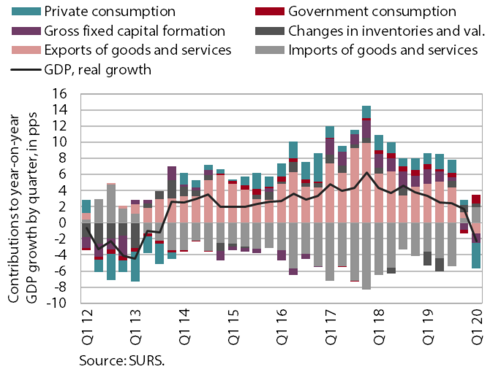
In the first quarter of 2020, real GDP declined by 2.3% year on year. With increased uncertainty and the closure of all non-essential service activities due to the measures to contain the COVID-19 epidemic in mid-March, the decline was mainly attributable to the fall in the group of trade, transportation and accommodation and food service activities. Household consumption dropped noticeably. Gross fixed capital formation declined as well, mainly as a consequence of lower investment in machinery and equipment. Exports and imports also declined, due to a fall in world trade and international trade barriers. Final government consumption was the only consumption aggregate that strengthened year on year.
Trade, March 2020
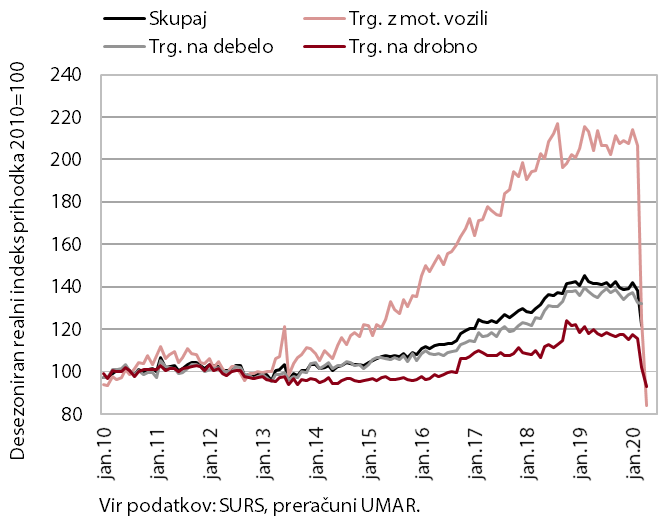
With the declaration of the epidemic and the closure of shops selling non-essential goods, turnover in trade fell sharply in March. In March and, according to preliminary data, also in April, the decline was largest in the sale of motor vehicles. With the adoption of measures to contain the spread of the virus and a decline in motor vehicle traffic, a significant decline was also recorded in retail sales of automotive fuels. Turnover was also down year on year in retail trade in non-food products, where, amid a fall in most sectors, increased turnover was recorded in the sale of pharmaceutical and medicinal products and in trade by mail order or the internet. Turnover in the sale of food products, which under the impact of uncertainty had already risen significantly in February, was also higher in March, while in April it was already slightly down year on year according to preliminary data.
Market services, March 2020
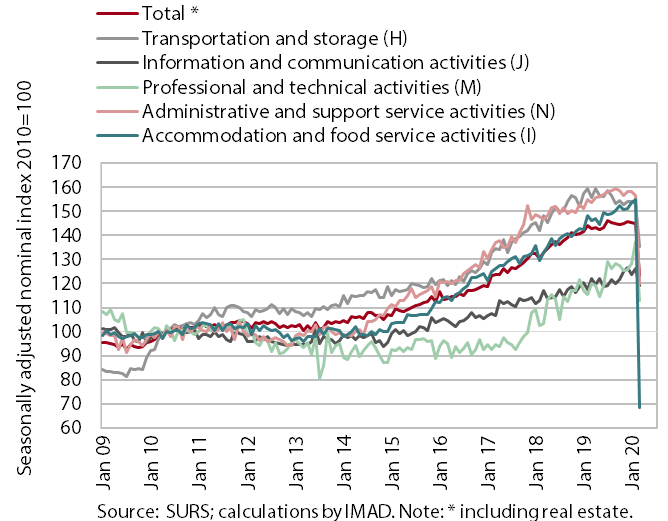
Turnover growth in market services plunged in March in most services. With the introduction of measures to contain the epidemic and hence the closure of all hotels and restaurants and the country’s borders, turnover declined the most in accommodation and food service activities. All of this also affected activities of travel agencies, which together with insurance agencies contributed to a sharper decline in other administrative and support service activities. Owing to a sharp fall in turnover in architectural and engineering services, a considerable decline was also seen in professional and technical activities. Turnover also fell in transportation, mainly due to a complete shutdown of public passenger transport. The smallest decline was in information and communication activities, which we estimate is mainly related to the sale on the domestic market.
Economic sentiment, April 2020
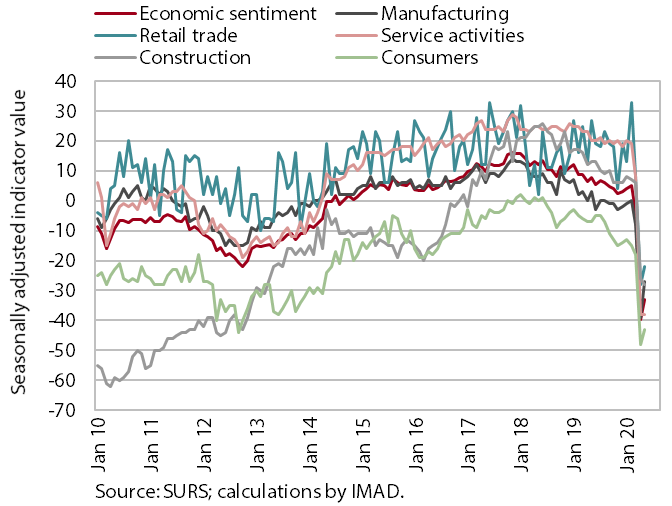
After a significant deterioration in economic sentiment in April, the indicators of expectations improved slightly in May but remained significantly below the level seen at the beginning of the year. Due to the spread of the coronavirus epidemic, besides a significant deterioration in the situation indicators, all activities also saw a sharp decline in expectations. Confidence declined the most in service activities and retail trade. Consumer confidence also fell, to the lowest level since the first measurement (since 2005). In May, the indicators of expectations otherwise improved slightly but remained significantly lower than at the beginning of the year. In all activities with the exception of construction, in May confidence was lower than during the economic and financial crisis ten years earlier.
Registered unemployment, April – May 2020
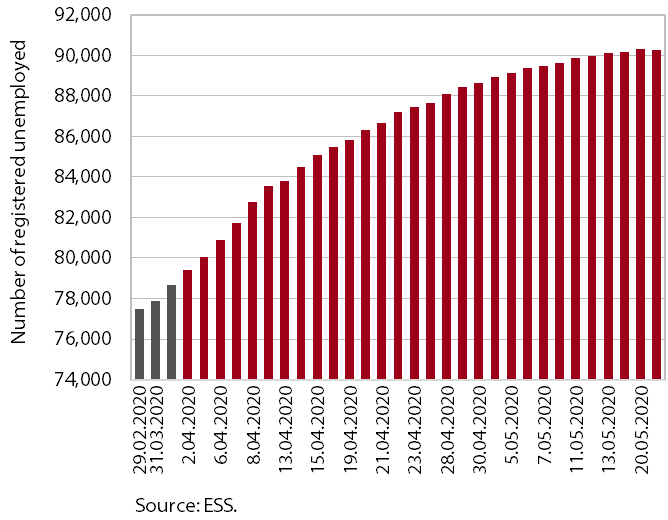
The number of registered unemployed persons started to increase markedly in the middle of March, but in the last few weeks its growth has eased considerably. By the end of April, the number of unemployed persons had risen to 88,648, which is 19.9% more than one year earlier. On 28 May, 90,387 persons were unemployed according to EES unofficial (daily) data, 2% more than at the end of April. Among the newly registered, there were significantly more persons who lost work because their fixed-term employment contracts were not extended (a reason more frequently cited among younger age groups) or for business reasons than before the outbreak of the epidemic. The inflow into unemployment came mainly from accommodation and food service activities, trade and manufacturing. With a smaller inflow into and a larger outflow from employment, the rise in the number of unemployed persons has eased noticeably in recent weeks, which is related to the easing of containment measures, the resumption of some activities and the adoption of the second legislative package to mitigate the economic impact of the crisis.
Traffic of electronically tolled vehicles on Slovenian motorways, April – May 2020
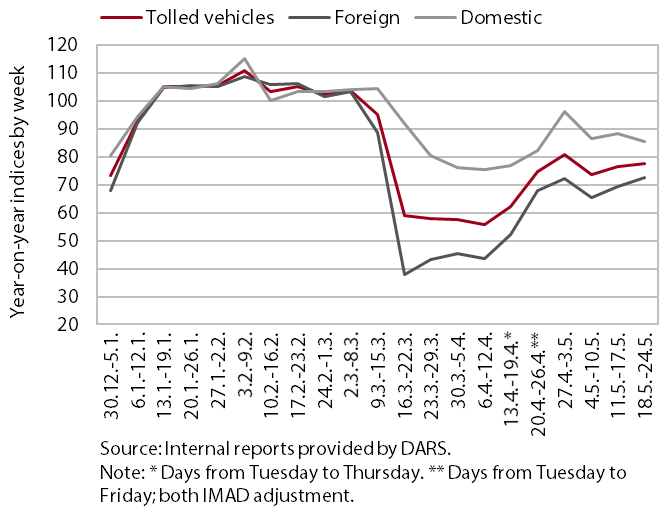
Freight traffic on Slovenian motorways fell markedly after the adoption of measures to contain the epidemic; the renewed increase seen since mid-April slowed in May. After an almost 40% decline in the first weeks of March, truck traffic was still more than one fifth lower year on year in the third week of May. Compared with the same period one year before, the distance of journeys performed by foreign trucks was almost 30% lower, while the decline in the distance performed by domestic trucks was significantly smaller. The fall in foreign truck traffic, which was initially much more pronounced than in domestic truck traffic, has decreased under the impact of EU measures for the free flow of goods across borders and due to the easing of measures in some neighbouring countries.
Electricity consumption, May 2020
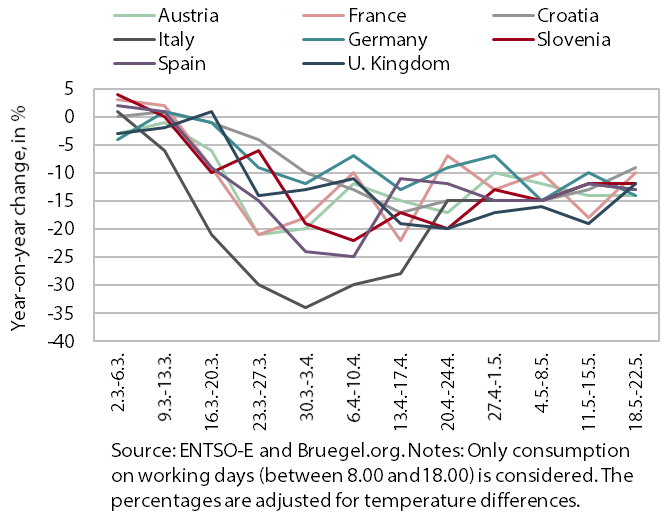
After a pronounced decline in March and April, the year-on-year drop in weekly electricity consumption started to decline gradually in May. Electricity consumption, one of the indicators of economic activity, was 12% lower in Slovenia in mid-May than in the same period of last year. More and more measures being relaxed, in the middle of May consumption also fell less than in previous weeks in most other countries. The only exception is Germany, with a 13% average decline in weekly consumption, which is more than the average weekly decline from the beginning of the crisis up to the end of April, when it was 9.5%.
Consumer prices, May 2020
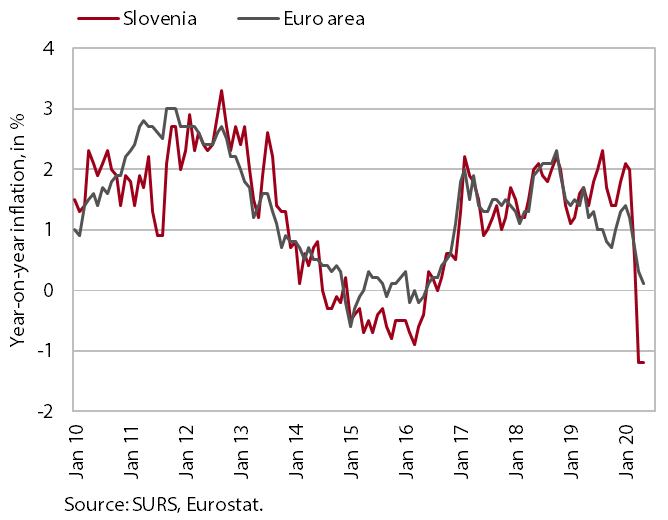
The year-on-year price decline remained at 1.2% in May. Overall, the greatest contribution to deflation came from lower prices of energy (oil products and electricity), which lowered inflation by 2.4 pps according to our estimate. Without the countercyclical adjustment of excise duties on motor fuels, the negative contribution would have been even greater. Prices of semi-durable and durable goods remain lower year on year (by 2.9% and 2.3% respectively). Food price growth continues. Owing to above-average seasonal growth, year-on-year growth in prices of fresh fruit rose significantly in May, to 23.4%, which we estimate is a consequence of greater demand and a worse harvest (frost). Growth in meat prices also remains high. Growth in prices of services strengthened somewhat in May after easing in previous months.
